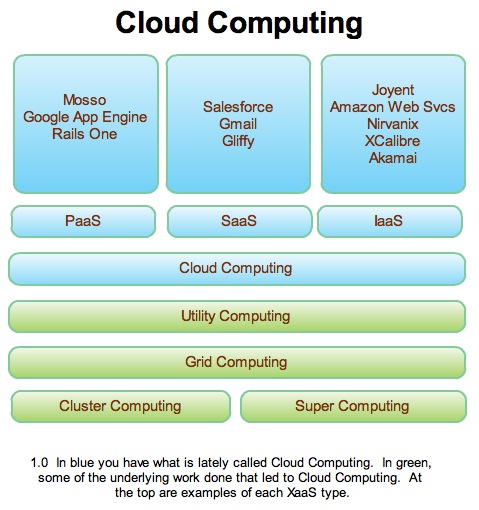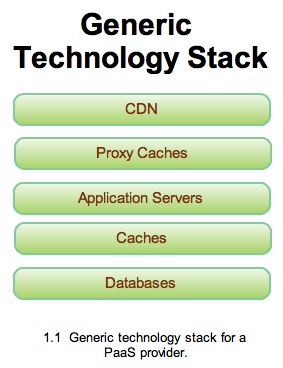Almost every day recently I find myself explaining Cloud Computing to different people at all levels and roles in various organizations. So, I decided to take a stab at it from my point of view. The challenge in explaining cloud computing is that there is more than one answer to the what is it question. The field is evolving rapidly and everyone wants a piece now. This article attempts to define and break down cloud computing to it's most important components in the context of the business use case. This article is for the potential cloud computing consumer. So, what is cloud computing?
Cloud Computing (Figure 1.0) is a commercial extension of computing resources like computation cycles and storage offered as a metered service similar to a physical public utility like electricity, water, natural gas, or telephone network. It  enables a computing system to acquire or release computing resources on demand in a manner such that the loss of any one component of the system will not cause total system failure. Cloud computing also allows the deployment of software applications into an environment running the necessary technology stack for the purposes of development, staging, or production of a software application. It does all this in a way that minimizes the necessary interaction with the underlying layers of the technology stack. In this way cloud computing obfuscates much of the complexity that underlies Software as a Service (SaaS) or batch computing software applications. To explain better though, let's simplify that and break it down this definition to it's constituent parts.
enables a computing system to acquire or release computing resources on demand in a manner such that the loss of any one component of the system will not cause total system failure. Cloud computing also allows the deployment of software applications into an environment running the necessary technology stack for the purposes of development, staging, or production of a software application. It does all this in a way that minimizes the necessary interaction with the underlying layers of the technology stack. In this way cloud computing obfuscates much of the complexity that underlies Software as a Service (SaaS) or batch computing software applications. To explain better though, let's simplify that and break it down this definition to it's constituent parts.
More compactly stated, cloud computing is a commercial extension of utility computing that enables scalable, elastic, highly available deployment of software applications while minimizing the level of detailed interaction with the underlying technology stack itself.
Definitions of Necessary Terms to clarify and define cloud computing:
Utility Computing - The combination of computing resources as a metered service in a way similar to a physical public utility.
Scalability - The ability of a computing system to grow relatively easily in response to increased demand
Elasticity - The ability of a system to dynamically acquire or release compute resources on-demand
Highly Available - Systems designed such that the loss of any one component of a system will not result in system failure
Deployment - Placing your software application into a technology stack in a running environment for development, testing, or production
Software Application - An arrangement of programming code designed to achieve some specific purpose
Technology Stack - The Hardware and Software layers underlying a given software application. Figure 1.1.

Now we know what cloud computing is and that's great. But, I'll let you in on a little secret. For most people, it just doesn't matter! Remember, we're talking about cloud computing in the context of business. We're not talking about buzz words, technobabble, or hope. Let's get to the really important question. How can all this cloud computing alphabet soup help my business or my idea flourish? Starting again with that question and keeping it in mind at all times you and your technology team can make pragmatic decisions over time. You may have heard it before, and it bears repeating, that there is no place in day to day businesses for technology for technologies sake alone in most companies. Technology, cloud related or otherwise, has to make good business sense to make any sense at all.
To decide if cloud computing can help your idea or business flourish you have to decide what type of service provider you need. There are three distinct sub-areas of cloud computing. They are IaaS, PaaS, and SaaS. We will define and discuss these in turn.
Infrastructure as a Service (IaaS)
IaaS clouds make it very easy and affordable to provision resources such as servers, connections, storage, and related tools necessary to build an application environment from scratch on-demand. IaaS clouds are the underlying infrastructure of PaaS and SaaS clouds. A common characteristic of IaaS clouds is that they are more complex to work with but with that complexity comes a high degree of flexibility. So, these are generally lower level services in the grand scheme of things; not in a derogatory sense of course. You'll be dealing with virtual machines, operating systems, patches, and various other issues. You'll likely require some specialized help to make it all work well.
Some current examples of these types of services are (some of these are hybrids too but I put them where the most belong in my opinon).
Amazon Web Services - Extremely flexible Build your own w/ many add-ons
VMWare - Build your own
Elastra - Up an comer build and manage your own IaaS
3Tera - Sexy GUI based IaaS/PaaS building tools
Xen - Build your own
XCalibre - Very interesting and can do Linux or Windows
Nirvanix - All about cloud storage, very interesting subset similar to Amazon S3
EngineYard - Rails only Build your own
Joyent - Build your own on Solaris w/ Java/PHP/Rails/Python
The number one benefit of such services is rapid provisioning. You will not have to wait days, weeks, or months for new servers. In some cases, you can have them in minutes! In fact, it's so easy to provision that it's easier to just throw away "broken" servers and replace them with new instances in most cases. All the details of provisioning, racking, stacking, cabling, and more are completely abstracted away from you.
The developers of applications for such systems will often need to adjust things to accommodate for the IaaS cloud. It can also be somewhat difficult to move from one cloud to another in some cases. But, less so with IaaS clouds than the PaaS clouds we will discuss next.
Billing for these services is usually incremental by use and can get complex with tiered on-demand pricing that can be difficult to track in real time. Pricing is usually well defined but can be rather difficult to forecast in some cases. It can vary to the minute depending on levels of use, tiers of service, and other interesting combinations. Now, on to the second type of cloud computing model that's important in the context of this article.
Platform as a Service (PaaS)
PaaS clouds are designed, often within IaaS Clouds by experts to make the deployment and scalability of your application trivial and your costs incremental and reasonably predictable. Here are a few of the choice Application Stack Cloud Providers (ASCP) in this space today.
Mosso, PHP, .NET, Java, Rails, Python, other?
Google App Engine, Python
SalesForce - Proprietary
Morph - Ruby on Rails
Heroku - Ruby on Rails
There are more and more PaaS clouds sprouting up constantly and rapidly. The number one benefit of such a service is that for very little money, none in some cases, you can launch your application with little effort beyond having developing and and possibly some porting work if it's an existing application. Additionally, there will be a large degree of scalability built into your PaaS choice by design as it is a cloud as defined earlier in the article. Finally, you will not need to hire a professional systems administrator more than likely as they are part of the service itself. If you are trying to keep your operations staff lean this can be a useful path to follow assuming your application will capitulate.
The number one down side of choosing an PaaS Cloud provider is that all such services come with various restrictions or trade-offs that may be a non-starter for your project. This is especially true of you already have a pre-existing application that might need to be ported to the PaaS solution you choose. You will need to plan on some porting development time costs and it might not be trivial. For example, a particular PHP extension, rails gem, or operating system tool may be unavailable that your application needs and you'll have to code around these types of issues as your ability to add this to an Application Platform Cloud will be limited unless it's a custom PaaS.
Billing for these services varies. It can be by the hour, request, CPU cycle, or other creative ways. Some even help you do pass through billing for your customers; like Mosso. But, the defining factor in pricing of Application Platform Clouds is that they generally strive to be robust, simple, and easy to load your application into when you are ready.
Software as a Service (SaaS)
Software as a Service has been around for a while now and actually precedes the newer term Cloud Computing. What's interesting, and the reason to include SaaS in this article is that Cloud Computing is breathing ever more life into the SaaS model by reducing the costs associated with producing a SaaS application. A couple of well known examples of SaaS are GMail or Salesforce.
SaaS is not really the ultimate goal of Cloud Computing per say but it is an important, relevant, and right now step along the evolution of compute resource management and allocation.
In summary, understanding cloud computing requires some base knowledge and historical review to know where it came from. This will enlighten people that it's not exactly new but that there is a new excitement now due to technology and business convergence. Once you have that base, which you now do, explicitly learning to use the cloud is the next step. Then, you can almost certainly implement your ideas faster, cheaper, and more profitably than people have ever been able to do before. It's a very exciting time to be in computing and in fact, to be on this planet. Welcome to the clouds!